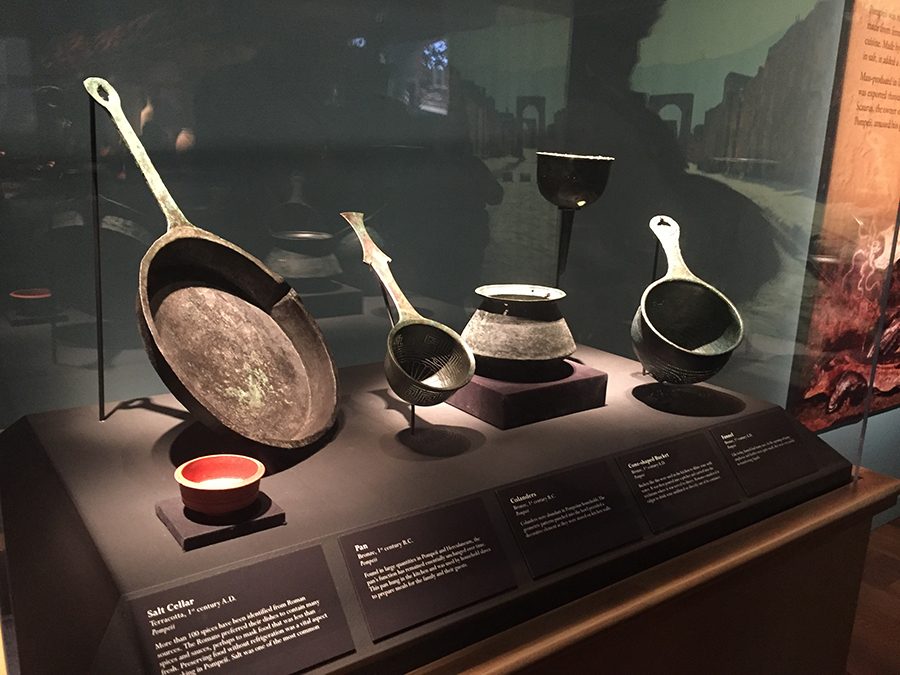Pompeii exhibit premiers at Union Station
Visitors have a chance to experience life in Ancient Rome and the last fateful day in Pompeii at Pompeii: The Exhibition at Union Station. This is the North American premiere of the Exhibit, with most of the artifacts being out of Europe for the first time.
Kitchen utensils from Pompeii in Ancient Rome sit on display at Pompeii: The Exhibition at Union Station in Kansas City. photo by Lily Manning
January 19, 2017
It is just a normal day, the sun is shining as Mount Vesuvius looms in the distance of the beautiful city of Pompeii. In the span of a few hours the day goes from serene to chaotic. The ground shakes beneath the ancient Romans as rumbling is heard in their ears. Mount Vesuvius can be seen with a cloud of ash above it. This ash blankets the entirety of Pompeii and preserves the city in a stunningly disastrous 48 hours.
Pompeii: The Exhibition offers people a chance to experience life in Pompeii before and during the eruption of Mount Vesuvius that destroyed the ancient Roman city in 79 A.D.. The exhibit holds nearly 200 artifacts that have been preserved and are on loan from Naples National Archaeological Museum in Italy. The majority of these artifacts are authentic from Pompeii, except for the casts of the bodies found at Pompeii that you can browse towards the end of the exhibit. It is the first time these artifacts have been in the United States, and for some, the first time they have ever been out of Italy.
In an interview with the Kansas City Star, vice president of Exhibitions International spoke of the significance of the preservation of Pompeii.
“It’s the only archeological site still active where, for literally one moment in time, we have a snapshot of what life was like on that day, at that second,” Brown said.
The exhibit details the look of life in the Roman Empire. In the same interview, Brown spoke of the interest people have in this exhibit.
“People are just innately interested in how other people lived in other times,” said Brown. “That’s one of the ways this exhibition really succeeds. You’re looking at how a family would have lived in Pompeii in 79 A.D., but you’re looking at people all across the spectrum, from tradesmen to the elite to politicians.”
The exhibit first guides visitors through a gallery where they get a look at housing in ancient Rome through a model, then walks visitors through Romans’ daily meals, even displaying kitchen utensils including a pan and spice holders. Visitors then walk through a gallery that gives details of an ancient Roman forum, where a Roman would buy and trade goods. This portion of the gallery shows off artifacts including golden jewelry, coins and ancient fishing equipment, and even features drone footage from above the forum.
The next gallery shows a description of other aspects of Roman life, including their intricate public baths and graffiti painted on city walls. Just another room over lies the exhibit’s “selfie spot” where a visitor can take a picture with cardboard replicas of Roman mosaics. Here also lies gladiator equipment and a description of the very popular gladiatorial games in Ancient Rome.
Visitors then walk into an all black room, where they experience a simulation of that fateful day in Pompeii. This portion of the exhibit includes fog, video, sound and a shaking floor to enhance the experience.
The next section of the exhibit features casts of the bodies preserved by ash and found at Pompeii’s ruins. This gallery includes casts of women, men, children and even a dog, all in the same position as when Vesuvius erupted.
The exhibit costs $19.95 for adults 13 and up and $15.95 for children ages three to twelve. It is open at Union Station from 10 a.m. to 5 p.m., Monday through Thursday, 10 a.m. to 7 p.m. Friday and Saturday and 11 a.m. to 5 p.m. on Sunday. The exhibit will be showing through spring of 2017.




